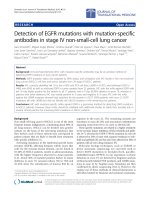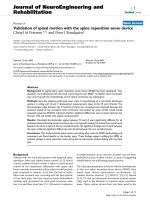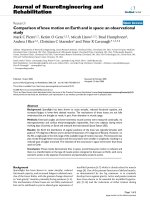Báo cáo hóa học: "Coupling of Semiconductor Nanowires with Neurons and Their Interfacial Structure" pdf
Bạn đang xem bản rút gọn của tài liệu. Xem và tải ngay bản đầy đủ của tài liệu tại đây (470.72 KB, 6 trang )
NANO EXPRESS
Coupling of Semiconductor Nanowires with Neurons
and Their Interfacial Structure
Ki-Young Lee
•
Sojung Shim
•
Il-Soo Kim
•
Hwangyou Oh
•
Sunoh Kim
•
Jae-Pyeong Ahn
•
Seung-Han Park
•
Hyewhon Rhim
•
Heon-Jin Choi
Received: 26 October 2009 / Accepted: 16 November 2009 / Published online: 4 December 2009
Ó The Author(s) 2009. This article is published with open access at Springerlink.com
Abstract We report on the compatibility of various
nanowires with hippocampal neurons and the structural
study of the neuron–nanowire interface. Si, Ge, SiGe, and
GaN nanowires are compatible with hippocampal neurons
due to their native oxide, but ZnO nanowires are toxic to
neuron due to a release of Zn ion. The interfaces of fixed Si
nanowire and hippocampal neuron, cross-sectional sam-
ples, were prepared by focused ion beam and observed by
transmission electron microscopy. The results showed that
the processes of neuron were adhered well on the nanowire
without cleft.
Keywords Nanowires Á Neurons Á Coupling Á Interfaces Á
TEM
Introduction
Semiconductor nanowires have high aspect ratio, high
surface area, and single crystallinity and thus are ideal
building blocks for many devices on a nanometer scale [1,
2]. Among these, nanowire-based neuron devices that can
monitor or stimulate neurons on a submicron dimension
with high sensitivity have been recently noticed for their
great potential in neuroscience [3]. To realize a nanowire-
based neuron device, coupling of nanowires with neurons
is essential. Previous studies have shown that the coupling
of Si or GaP nanowires with neurons is feasible [4, 5].
However, other semiconductor nanowires that can be
considered for neuron devices have not yet been investi-
gated. Meanwhile, monitoring or stimulating of neurons is
strongly dependent on the nature of the interfaces between
them [6, 7]. For example, the electronic coupling strength
between neurons and devices is primarily dependent on the
distance between the membrane and the device surface [8,
9]. In fact, the weak coupling between neuron and devices
due to the extracellular cleft is one of the major problems
in neuron-electronic interfaces. Analysis of the interfacial
structures is thus essential in the design of nanowire-based
neuron devices as well as for understanding the signal
transfer mechanism. In the present study, we investigate
the coupling of group IV (Si, Ge and SiGe), III-V (GaN),
and oxide (ZnO) semiconductor nanowires with hippo-
campal neurons that are believed to be involved in the
general and spatial memory, and characterize the coupled
interface via transmission electron microscopy (TEM). Our
results indicate that IV and III-V semiconductor nanowires
are compatible with the neurons, whereas oxide semicon-
ductor nanowires are not compatible. Characterization of
the coupled Si nanowire–neuron interfaces shows two
layers comprised of a coupling modifier and natural oxides
K Y. Lee Á S. Shim Á I S. Kim Á H. Oh Á H J. Choi (&)
Department of Materials Science and Engineering,
Yonsei University, Seoul 120-749, South Korea
e-mail:
S. Kim
Jeonnam Natural Resources Research Institute, Jangheung-Gun,
Jeollanamdo 529-851, South Korea
J P. Ahn
Advanced Analysis Center, Korea Institute of Science
and Technology, Seoul 136-791, South Korea
S H. Park
Department of Physics, Yonsei University, Seoul 120-749,
South Korea
H. Rhim (&)
Center for Chemoinformatics Research, Korea Institute
of Science and Technology, Seoul 136-791, South Korea
e-mail:
123
Nanoscale Res Lett (2010) 5:410–415
DOI 10.1007/s11671-009-9498-0
with a thickness of *8 nm. No clefts were found at the
interfaces.
Experimental Procedure
Synthesis of Nanowires
We synthesized Si (a), SiGe (b), Ge (c), and GaN (d) nano-
wires on a (a–c) Si (111) and (d) c-plane sapphire substrates
coated with (a–c) Au, and (d) Ni as a VLS catalyst by a
conventional CVD process employing (a) silicon tetrachlo-
ride (SiCl
4
, Alfa, 99.999%) as a silicon source, (b) SiCl
4
as a
silicon source and germanium powder as the germanium
source, (c) germanium tetrachloride (GeCl
4
, Alfa, 99.999%)
as a germanium source, and (d) metallic Ga powder as a
gallium source and ammonium gas as a nitrogen source
[10–13]. The substrates were placed in the center of quartz
tube, and powder sources were also placed at the near of
substrates with a distance of 1 in. Carrier gas transfers the
source precursor through a bubbler to the quartz reactor, and
hydrogen and argon gas were used as diluent gases, which
regulate the concentration of the mixture containing source
gas and carrier gas. The temperature of the furnace was
increased at a heating rate of 50 °Cmin
-1
to 800 °C under
flow of source and carrier gases and kept for 10 through
60 min and then cooled down to room temperature. ZnO
nanowires were grown by a typical carbothermal reduction
process. An equal amount of ZnO and graphite powders were
mixed and transferred to an alumina boat inside the pro-
cessing tube. The processing temperature varied from 800 to
950 ° C[14]. The all prepared nanowires were observed by a
scanning electron microscopy.
Cell Culture
The nanowires were dispersed in ethanol and laid on the Si
wafer. After sterilization by ethanol and UV light, the
surface of the nanowires was chemically modified by a
poly-
L-lysine (PLL) coating for cell adhesion. Hippocam-
pal neurons were then cultured on the nanowires. Briefly,
the hippocampal neurons were isolated from 16- to 18-day-
old fetal Sprague–Dawley rats and incubated with 0.25%
trypsin Hanks balanced salt solution (HBSS) at 37 °C for
15 min. Cells were then mechanically dissociated with fire-
polished Pasteur pipettes by trituration and plated on pre-
pared substrata in a 24-well-plate culture dish. Cells were
maintained in Neurobasal/B27 medium containing 0.5 mM
L-glutamine, 25 lM glutamate, 25 lM 2-mercaptoethanol,
100 units ml
-1
penicillin, and 100 lgml
-1
streptomycin.
50,000 cells were incubated with a substrate deposited in a
well of the 24-well plate at 37 °Cin5%CO
2
incubator.
Results and Discussion
Figure 1a–e are a typical SEM images of various NWs
grown on the substrate. The NWs grew with the diameter
Fig. 1 Typical SEM image of Si (a), SiGe (b), Ge (c), GaN (d) and ZnO (e) nanowires. Scale bar is 60 lmina,30lminb,10lminc and d,
and 3 lmine
Nanoscale Res Lett (2010) 5:410–415 411
123
ranging from 40 to 150 nm and lengths of several tens
micrometer, respectively.
Figure 2a–f show SEM images of hippocampal neurons
cultured for 4–5 days on the nanowires. To observe the
morphology of the neuron cells by scanning electron
microscopy (SEM), they were treated via a critical point
drying technique after the treatment with glutaraldehyde
for fixation and osmium tetroxide for contrast enhance-
ment. In comparison with a standard sample (i.e., cultured
neurons on a PLL-coated silica substrate), hippocampal
neurons were grown similar to a standard one with many
protruding processes, except for the case of ZnO nano-
wires. This outcome implies that, in addition to Si nano-
wires [4], which have already shown a compatibility with
neurons, SiGe, Ge, and GaN nanowires are compatible
with hippocampal neurons. Our previous studies have
shown that the surfaces of Si, SiGe, Ge, and GaN nano-
wires consist of SiO
x
, SiO
x
, GeO
x
, and Ga
x
O
y
, respectively,
[11, 15–17] as a result of natural oxidation. These native
oxides come into substantial contact with the neurons and
may contribute to the compatibility of the nanowires. SEM
images of the neurons cultured with ZnO nanowires,
meanwhile, reveal that growth processes were less devel-
oped in comparison with the other cases. This indicates that
these nanowires may be toxic to neurons. To verify this, a
MTT assay, a technique widely used to measure cell via-
bility, was performed on the neurons cultured with ZnO
nanowires, and the results were compared with those
obtained for Si nanowires. Si and ZnO nanowires were
incubated with hippocampal neuron (50,000 cells). For
adhesion cells, we removed the media and replace it with
fresh culture medium. For labeling, we added 12-mM MTT
stock (3-(4,5-dimethylthiazol-2-yl)-2,5-diphenyltetrazoli-
um bromide) and incubated at 37 °C for 3–4 h. For
detecting, we added dimethyl sulfoxide (DMSO) to each
well and mix thoroughly with the pipette and incubated at
37 °C for 30 min with shaking helps solvate well the for-
mazan. We read absorbance at 540 nm. Earlier mentioned
procedure was performed at 0, 24, 48, and 72 h. As shown
in Fig. 3, the activity of neurons cultured with ZnO
nanowires decreased with culture time while that with Si
nanowires increased. This shows that ZnO nanowires are
Fig. 2 SEM images of 4–5 days cultured hippocampal neurons with various nanowires (a: PLL-coated silica substrate without nanowires, b: Si,
c: SiGe, d: Ge, e: GaN, f: ZnO, Scale bar is 15 lmina–e and 6 lminf)
Fig. 3 The absorption rate result of MTT assay for hippocampal
neuron in 72 h (filled square: control, filled triangle: negative control,
filled down pointing triangle: Si NW, filled diamond: ZnO NW, at
540 nm)
412 Nanoscale Res Lett (2010) 5:410–415
123
toxic to hippocampal neurons. One possible explanation for
this is dissolution of Zn from the nanowires in the course of
culturing. It is known that Zn release contributes to neural
death [18, 19]. To confirm this, the culture media with ZnO
and Si nanowires were analyzed by inductively coupled
plasma mass spectroscopy (ICP). The results showed
revealed Zn content of 6.6 ppm and Si content of\2 ppm,
where the former is ten times higher than the value of the
standard sample and the latter corresponds with those,
respectively. Therefore, it could be concluded that the
dissolution and release of Zn ions are responsible for the
neurotoxicity of the ZnO nanowires.
Since Si nanowires were identified as being biocom-
patible to neurons in the SEM, MTT assay, and ICP
analyses, the Si nanowire–neuron couple was selected to
investigate the interfacial structure. We prepared ultrathin
cross-sectioned samples and characterized by using TEM
for direct observation of interfaces on a nanometer scale.
The couples were first dried by critical point drying tech-
nique that is widely used to observe cellular morphology
without deformation [20, 21]. After drying treatment, the
coupled interface was cross-sectioned using a high-reso-
lution Cross Beam FIB-FESEM instrument, and the side-
wall of the cross section was polished with a low-ion
current and imaged in situ by SEM until a width of less
than 80 nm, after which it was observed by TEM.
Figure 4a shows the one of the coupled neurons with Si
nanowires where the neuron wraps the nanowires in an
omega (X) shape. Figure 4b shows a cross-sectioned image
of the neuron–nanowire interface. The entire cross-sec-
tional interfacial structure was well preserved, and distinct
shrinking artifacts were not found. Figure 4c–e show the
Fig. 4 a SEM image of coupled Si nanowire with neuronal process.
b Cross-sectioned image of neuron–nanowire interface showing
neuron (N), Si nanowires (Si), gold (Au) and platinum (Pt) films
deposited for focused ion beam process. c–e Element mapping of
cross-sectional interfaces obtained by jump-ratio method in TEM
analysis (c: silicon, d: oxygen, e: carbon). Each mapping shows *8,
*4, and *8 nm of interfacial layers, respectively, f High-resolution
TEM image of interface showing *4 nm of SiO
2
(bright, below) and
*4 nm of PLL (dark, above) layers. Scale bar is 1 lmina, 200 nm
in b–e and 10 nm in f
Nanoscale Res Lett (2010) 5:410–415 413
123
representative results of element mapping of cross-sec-
tional interfaces obtained by the jump-ratio method in the
TEM analysis. The silicon jump-ratio image shows the Si
nanowire (Fig. 4c), the oxygen jump-ratio image shows the
silicon oxide layer (Fig. 4d), and the carbon jump-ratio
image shows the PLL layer and neuronal process with
bright contrast (Fig. 4e), respectively. The analysis
revealed that the neuronal process attached tightly to the Si
nanowire without any cleft, and the interfaces consisted of
a multilayer of neuron/PLL/SiO
2
/nanowires. The high-
resolution TEM image (Fig. 4f) also shows an interfa-
cial layer with a thickness of about 8 nm consisting of a
*4-nm layer of SiO
2
and *4-nm PLL layer.
In the earlier mentioned characterization studies, no
clefts, which might be caused by filled culture medium
before drying, were found. In the previous characteriza-
tions of the interfaces between human embryonic kidney
(HEK) cell and a Si field effect transistor (FET) [21]or
cells on a SiO
2
substrate [22], cleft with an average width
of roughly 40 nm was observed, depending on the type of
modifier. It is not clear why such clefts have not been
observed in the present neuron–nanowires interfaces. It
may due to the different growth behavior of the neurons on
the nanostructured surfaces formed by the nanowires when
compared to the flat FET surface [23] or the small contact
area on a nanometer scale. Regardless of the mechanism,
the neuron–nanowire couples may be advantageous for the
development of neuron devices in terms of signal transfer
and electronic coupling, since the clefts pose critical
problems in relation to signal transfer and electronic cou-
pling strength.
Many approaches can be considered for the fabrication
of nanowire-based neuron devices, including coupling
nanowire transistors to neurons [24, 25] and probing neu-
rons with vertical nanowire array [26]. In all of these cases,
the signal is transferred through the interface. In this
regard, the formation of tight-, very thin interfaces between
nanowires and neurons would lend promise for monitoring
and/or stimulating of neurons. Furthermore, as shown in
Fig. 4a, the neurons can wrap the nanowires in a X shape
or totally in the case of a vertical array. This aspect also is
potentially advantageous for highly sensitive monitoring
and/or stimulating of neurons, since and omega- or all-
surround gating effect is expected, akin to advanced tran-
sistor structures [27].
Conclusion
In summary, we investigated the compatibility of various
nanowires with hippocampal neurons. Si, Ge, SiGe, and
GaN nanowires were found to be compatible to neurons
under the present culturing conditions. However, ZnO
nanowires are toxic to neurons as a result of the release of
Zn ions from the nanowires. The interface of coupled Si
nanowires and neurons shows no clefts and is comprised of
a SiO
2
layer of 4 nm and a PLL coating layer of 4 nm.
Formation of omega-shaped, tightly bonded interfaces with
very thin interfacial layers is promising for monitoring and/
or stimulating neurons by nanowires.
Acknowledgments This research was supported by a grant from the
National Research Laboratory program (R0A-2007-000-20075-0) and
Pioneer research program (2009-008-1529) for converging technol-
ogy through the Korea Science and Engineering Foundation funded
by the Ministry of Education, Science & Technology.
Open Access This article is distributed under the terms of the
Creative Commons Attribution Noncommercial License which per-
mits any noncommercial use, distribution, and reproduction in any
medium, provided the original author(s) and source are credited.
References
1. J. Xian, W. Lu, Y. Wu, H. Yan, C.M. Lieber, Nature 441, 489
(2006)
2. C. Yan, J. Liu, F. Liu, J. Wu, K. Gao, D. Xue, Nanoscale Res.
Lett. 3, 473 (2008)
3. F. Patolsky, B.P. Timko, G. Yu, Y. Fang, A.B. Greytak,
G. Zheng, C.M. Lieber, Science 313, 1100 (2006)
4. W. Kim, J.K. Ng, M.E. Kunitake, B.R. Conklin, P. Yang, J. Am.
Chem. Soc. 129, 7228 (2007)
5. W. Ha
¨
llstro
¨
m, T. Ma
˚
rtensson, C. Prinz, P. Gustavsson,
L. Montelius, L. Samuelson, M. Kanje, Nano Lett. 7, 2960 (2007)
6. P. Bonifazi, P. Fromherz, Adv. Mater. 14, 1190 (2002)
7. A. Stett, B. Mu
¨
ller, P. Fromherz, Phys. Rev. E 55, 1779 (1997)
8. P. Fromherz, ChemPhysChem 3, 276 (2002)
9. M. Merz, P. Fromherz, Adv. Funct. Mater. 15, 739 (2005)
10. Y. Huang, C.M. Lieber, Pure Appl. Chem. 76, 2051 (2004)
11. A.B. Greytak, L.J. Lauhon, M.S. Gudiksen, C.M. Lieber, Appl.
Phys. Lett. 4, 4176 (2004)
12. G. Gu, M. Burghard, G.T. Kim, G.S. Du
¨
sberg, P.W. Chiu,
V. Krstic, S. Roth, J. Appl. Phys. 90, 5747 (2001)
13. H K. Seong, H. Jeong, R. Ha, J C. Lee, Y.M. Sung, H J. Choi,
Met. Mater. Int. 14, 354 (2008)
14. P. Yang, H. Yan, S. Mao, R. Russo, J. Johnson, R. Saykally,
N. Morris, J. Pham, R. He, H J. Choi, Adv. Funct. Mater. 12, 323
(2002)
15. X Y. Zhang, L D. Zhang, G W. Meng, G H. Li,
N Y. Jin-Phillipp, F. Phillipp, Adv. Mater. 13, 1238 (2001)
16. C. Qi, G. Goncher, R. Solanki, J. Jordan, Nanotechnology 18,
075302 (2007)
17. P. Nguyen, H.T. Ng, M. Meyyappan, Adv. Mater. 17, 549 (2005)
18. C.T. Sheline, M.M. Behrens, D.W. Choi, J. Neurosci. 20, 3139
(2000)
19. I.G. Gazaryan, I.P. Krasinskaya, B.S. Kristal, A.M. Brown,
J. Biol. Chem. 282, 24373 (2007)
20. F. Braet, R. de Zanger, E. Wisse, J. Microsc. (Oxford) 186,84
(1997)
21. G. Wrobel, M. Holler, S. Ingebrandt, S. Dieluweit, F. Sommerhage,
H.P. Bochem, A. Offenhausser, J. R. Soc. Interface 5, 213
(2008)
22. D. Braun, P. Fromherz, Phys. Rev. Lett. 81, 5241 (1998)
414 Nanoscale Res Lett (2010) 5:410–415
123
23. B. Wolfrum, Y. Mourzina, F. Sommerhage, A. Offenhausser,
Nano Lett. 6, 453 (2006)
24. A. Bindal, S. Hamedi-Hagh, Nanotechnology 18, 095201 (2007)
25. F. Patolsky, B.P. Timko, G. Zheng, C.M. Lieber, MRS Bull. 32,
142 (2007)
26. R. Fan, Y. Wu, D. Li, M. Yue, A. Majumdar, P. Yang, J. Am.
Chem. Soc. 125, 5254 (2003)
27. J.P. Colinge (ed.), FinFETs and Other Multi-gate Transistors
(Springer, Dordrecht, 2007)
Nanoscale Res Lett (2010) 5:410–415 415
123









